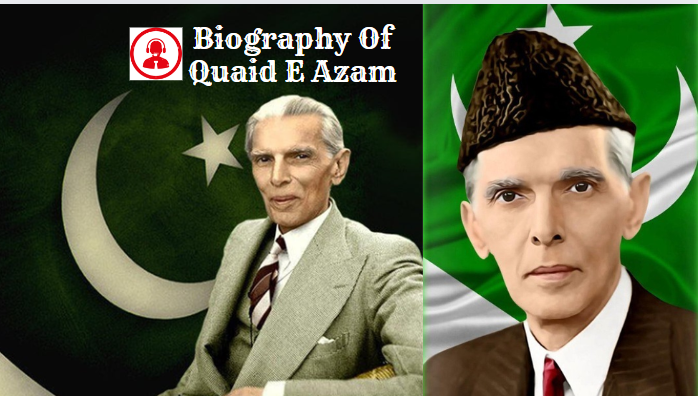Biography Of Quaid E Azam: Date Of Birth, Death, Education, Father, Religion
Biography Of Quaid E Azam – Who is Quaid E Azam? Muhammad Ali Jinnah, widely known as Quaid-e-Azam, was a towering figure in the history of South Asia. As the founder of Pakistan, his contributions to the political landscape and his role in the creation of a separate nation for Muslims are unparalleled. This biography looks into his early life, education, political career, and enduring legacy.
Let’s talk about the life and achievement of Quaid E Azam in detail
Quaid E Azam Education And Early Life
Born as Mahomedali Jinnahbhai on December 25, 1876, in Wazir Mansion, Karachi, Jinnah was destined for greatness from a young age. His father, Jinnahbhai Poonja, was a prosperous merchant, which provided Jinnah with the opportunity to receive a good education. As a young boy, he lived in Bombay with an aunt for a period, attending the Gokal Das Tej Primary School. Later, he studied at the Cathedral and John Connon School.
Upon returning to Karachi, Jinnah continued his education at the Sindh Madressatul Islam and the Christian Missionary Society High School. His academic journey then took him to London, England, where he trained as a barrister at Lincoln’s Inn. This legal education laid the foundation for his future career in law and politics.
Political Career and Achievements
Upon his return to India, Jinnah enrolled at the Bombay High Court. His legal practice quickly made way for a deep involvement in national politics. Jinnah’s early political career was marked by his advocacy for Hindu-Muslim unity. He rose to prominence in the Indian National Congress and played a crucial role in shaping the 1916 Lucknow Pact between the Congress and the All-India Muslim League.
Jinnah’s political philosophy underwent a significant transformation over the years. Initially a proponent of Hindu-Muslim unity, he eventually became a staunch advocate for the political rights of Muslims in the Indian subcontinent. By 1940, Jinnah was convinced that Muslims needed their own state to avoid marginalization in a predominantly Hindu India. This led to the historic Lahore Resolution, where the Muslim League, under Jinnah’s leadership, demanded a separate nation for Muslims.
The Creation of Pakistan
The turbulent years leading up to the independence of India saw Jinnah emerge as a key figure in the struggle for a separate Muslim state. The Second World War and the political developments that followed bolstered the Muslim League’s position. In the provincial elections held after the war, the League won most of the seats reserved for Muslims, solidifying Jinnah’s leadership.
The inability of the Congress and the Muslim League to agree on a power-sharing formula resulted in the partition of British India. On August 14, 1947, Pakistan was born, and Jinnah became its first governor-general. His efforts to establish the new nation’s government, policies, and support for Muslim migrants from India were monumental.
Quaid E Azam Wife – Personal Life and Legacy
Jinnah’s personal life was marked by dedication to his nation. He married Rattanbai Petit, with whom he had a daughter, Dina. Jinnah’s commitment to his vision for Pakistan often meant long hours of work and travel, impacting his health.
On September 11, 1948, Quaid-e-Azam Muhammad Ali Jinnah passed away at the age of 71. His death came just over a year after the creation of Pakistan, but his legacy endures. Jinnah is revered as the Quaid-e-Azam (Great Leader) and Baba-e-Qaum (Father of the Nation) in Pakistan. His birthday is a national holiday, celebrated with great reverence across the country.
Several universities, public buildings, and institutions in Pakistan bear Jinnah’s name, reflecting his lasting impact. According to his biographer, Stanley Wolpert, Jinnah remains Pakistan’s greatest leader, whose vision and determination shaped the country’s destiny.
FAQs
1. What is Quaid-e-Azam’s date of birth? Quaid-e-Azam Muhammad Ali Jinnah was born on December 25, 1876.
2. What is Quaid-e-Azam’s date of death? Quaid-e-Azam Muhammad Ali Jinnah passed away on September 11, 1948.
3. What was Quaid-e-Azam’s early education? Jinnah attended the Gokal Das Tej Primary School, Cathedral and John Connon School, Sindh Madressatul Islam, and the Christian Missionary Society High School.
4. Who was Quaid-e-Azam’s father? Jinnah’s father was Jinnahbhai Poonja, a prosperous merchant.
5. What was Quaid-e-Azam’s religion? Quaid-e-Azam Muhammad Ali Jinnah was a Muslim.
Conclusion
Quaid-e-Azam Muhammad Ali Jinnah’s life was a testament to his unwavering commitment to his vision for Pakistan. His journey from a young boy in Karachi to the founder of a nation is a story of determination, resilience, and leadership. Jinnah’s legacy continues to inspire generations, making him an enduring symbol of Pakistan’s identity and aspirations.

